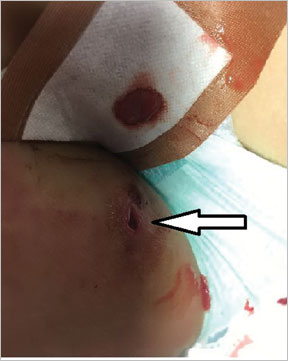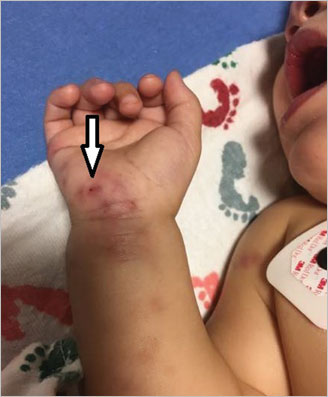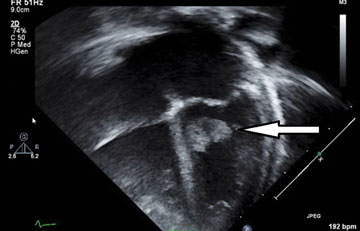Treatment is easy; diagnosis is hard


Source: James H. Brien, DO



A previously healthy 11-month-old female was seen in the ER for evaluation of an erythematous, somewhat painful papular lesion, diagnosed as impetigo and treated with topical mupirocin. Three days later, she was seen again, now with fever and cellulitis with an abscess on the proximal left thigh. Her temperature was 102.5°F, and the abscess was drained (without culture) and she was sent home, treated with trimethoprim/sulfamethoxazole. Five days later, with ongoing fever and the development of emesis, she returned to the ER, where her temperature was 103.2°F, with a pulse of 185 and tachypnea.
On exam, her left thigh was a bit swollen, and more pus was drained from the abscess (Figure 1), and she was admitted for treatment of possible sepsis. In the hospital, she was also found to have multiple discrete, erythematous, somewhat painful papular lesions, similar to the one on her left thigh earlier. They seemed to be clustered mostly on her right arm and hand (Figures 2 and 3), with a pustule on the hypothenar eminence. The rest of her exam was unremarkable.
Lab tests included a CBC with 39.2 WBCs (75% granulocytes), mild anemia, C-reactive protein level of 273, elevated liver enzymes (ALT = 243 and AST = 151), creatinine level of 0.57, abnormal coagulation studies, and a concentrated urinalysis. A Gram stain was obtained from the pustule and the left thigh abscess showing Gram-positive cocci in clusters. Cultures of the thigh wound, blood and the pustule from the hypothenar eminence are pending.
Her chest radiograph was clear, and echocardiogram is shown in Figure 4.
What is your empiric treatment?
A. Ceftriaxone + vancomycin
B. Ampicillin + gentamicin
C. Gentamicin + vancomycin + ceftriaxone
D. Ceftriaxone + nafcillin
Case Discussion
The blood, pustule and wound cultures grew MRSA, and the echocardiogram revealed a large vegetation involving the mitral valve, confirming the diagnosis of native valve endocarditis. While there are various acceptable empiric antimicrobial regimens, pending identification of the organism, the best answer of the choices given above would be C, gentamicin plus vancomycin and ceftriaxone. The most common organisms in native valve endocarditis, such as in this case, would be viridans group strep, Enterococcus, Staphylococcus aureus and the HACEK group (Haemophilus, Aggregatibacter, Cardiobacterium, Eikenella and Kingella). In a child who is septic, the best advice would be to treat for all these, including MRSA, pending culture results. When antimicrobial agents are chosen, it is advisable to select those with bactericidal activity, rather than static. The usual duration of therapy ranges from 4 to 6 weeks. Cases such as this, with a severe degree of cardiac dysfunction and sepsis, need to have surgical management as well. Therefore, this patient was transferred to Texas Children’s Hospital in Houston, Texas, for surgery to debride the vegetation, where she was also found to have multiple, small septic emboli to the brain and thrombi to both femoral arteries, one requiring thrombectomy. She recovered from the infection with residual mitral valve regurgitation.
Some classic clinical features of endocarditis include Osler nodes (painful immune complex cutaneous depositions), Janeway lesions (painless septic emboli, mostly about the distal extremities), Roth spots (immune complex formation resulting in hemorrhagic lesions in the retina) and splinter hemorrhages under the nails. The child in this case may have had both Osler nodes and Janeway lesions, as some were painful and some were not, and at least one was septic. Her eye exam was normal. The triggering event(s) are not known. The single best reference for review is the scientific statement by the American Heart Association, “Infective Endocarditis in Childhood: 2015 Update.”
Columnist Comments: Get your influenza immunization NOW.
- Reference:
- Baltimore RS, et al. Circulation. 2015;doi:10.1161/CIR.0000000000000298.
- For more information:
- James H. Brien, DO, is with the department of infectious diseases at McLane Children’s Hospital, Baylor Scott & White Health, Texas A&M College of Medicine in Temple, Texas. He also is a member of the Infectious Diseases in Children Editorial Board. Brien can be reached at jhbrien@aol.com.
Disclosure: Brien reports no relevant financial disclosures.
